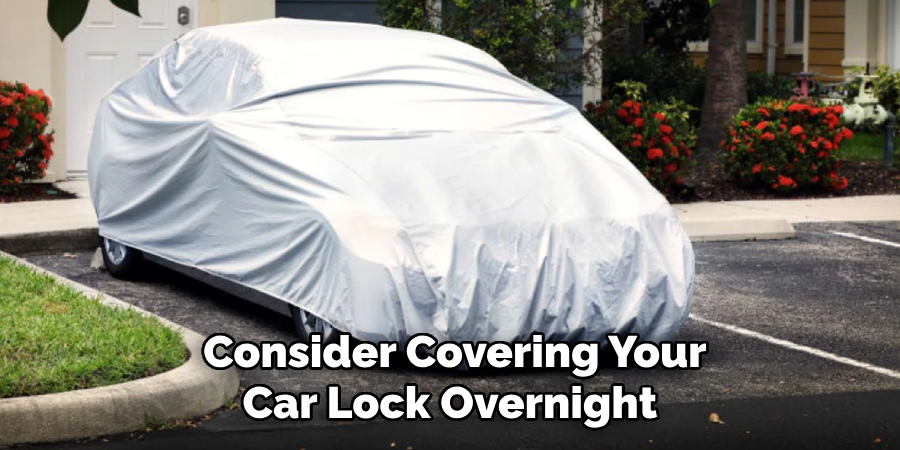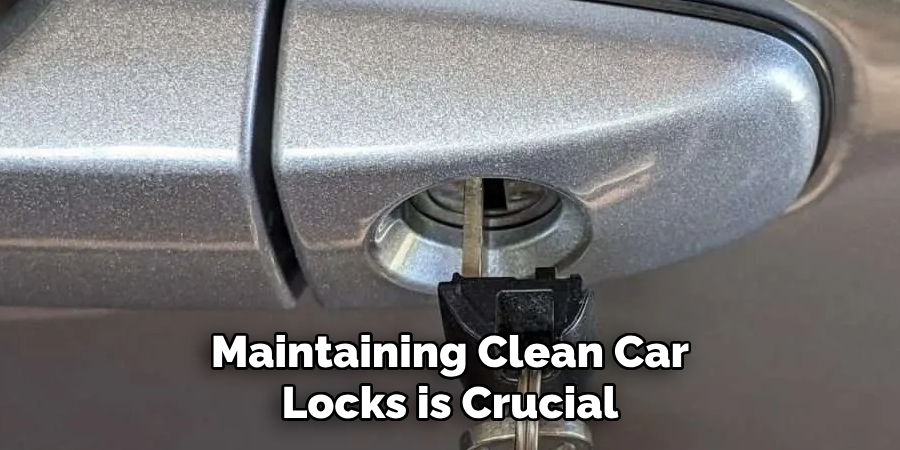Are you having trouble opening your car door locks in freezing temperatures? Cold weather can cause car door locks to freeze up, making it difficult to get into your vehicle. This can be frustrating and even dangerous if you’re in a hurry or need to access your car quickly.

Winter’s arrival brings not just the serene beauty of snow-covered landscapes but also the pesky challenge of car door locks freezing up. This common inconvenience can transform a simple task like starting your car in the morning into a frustrating ordeal.
Fortunately, with the right knowledge and some preventative measures, you can keep your car locks free from ice, ensuring a smooth and stress-free winter driving experience. In this guide, we’ll explore practical tips and tricks on how to stop car door locks freezing up, ensuring you’re not left out in the cold.
What Happens If Your Car Locks Freeze?
If your car locks freeze, it can be frustrating and inconvenient, but there are a few steps you can take to try and unfreeze them. First, try heating up your key with a lighter or by rubbing it on your clothing.
Then, gently insert and turn the key in the lock to see if it will open. You can also try using a lock de-icer spray or rubbing alcohol to melt the ice. If these methods don’t work, you may need to wait for the temperature to rise or call a professional locksmith.
However, it’s important to note that constantly trying to force open a frozen lock can damage it and potentially prevent access to your car. It’s best to take preventative measures rather than deal with a frozen lock in the first place.
Why do the Car Doors Freeze Up?
Before we discuss solutions, it’s essential to understand why car door locks freeze. As temperatures drop, moisture in the air can seep into your car’s lock mechanism and freeze when exposed to frigid temperatures. This ice buildup prevents the lock from functioning correctly, leaving you unable to open your car doors.

Additionally, if you frequently use water or liquid de-icers to thaw your car locks, this can also contribute to the freezing issue. These methods may temporarily melt the ice, but they can also create more moisture that will eventually refreeze and worsen the problem.
What Will You Need?
To effectively prevent your car door locks from freezing up, it’s important to have the right tools and materials at your disposal. The following items are essential for addressing and preventing frozen locks:
- Lock De-icer: A specialized formula designed to quickly melt ice within the lock mechanism without causing damage.
- Graphite Lubricant: After de-icing, this will keep the lock mechanism functioning smoothly, especially in cold weather.
- Straw or Small Tube: For precisely applying de-icer or lubricant into the lock mechanism.
- Magnetized Car Lock Cover: Optional but effective for preventing moisture from entering the lock area.
- Rubbing Alcohol: A home remedy for melting ice that can be used in a pinch.
- Soft Cloth: This is used to clean the lock and surrounding area before applying any preventative measures.
By keeping these items handy, especially during the colder months, you’ll be well-equipped to tackle frozen car door locks swiftly and efficiently.
10 Easy Steps on How to Stop Car Door Locks Freezing Up
Step 1. Apply Lock De-icer:
If you find your car door lock frozen, the first step is to apply a lock de-icer. Hold the de-icer close to the lock and insert the straw or nozzle directly into the lock mechanism. Spray liberally, allowing the de-icer formula to penetrate deeply into the lock.

This specially formulated solution works rapidly to melt the ice, freeing up the lock mechanism. Be prepared to wait a few moments as the de-icer does its magic. If you do not have a lock de-icer readily available, a small amount of rubbing alcohol can serve as a temporary substitute.
Step 2. Turn Key Gently:
Once the de-icer has had a chance to work, gently insert your key into the lock. Apply a slight, steady pressure as you turn the key. Avoid using excessive force to prevent damaging the key or lock mechanism. If the lock does not budge, apply a bit more de-icer and wait a few more minutes. The key here is patience; the de-icer needs time to fully penetrate and melt the ice within the lock mechanism.
Step 3. Use Graphite Lubricant:
After successfully opening your lock with a de-icer, it’s time to prevent future freezes. Use the straw or small tube to apply a small amount of graphite lubricant to the lock mechanism precisely. Graphite lubricant works well in cold temperatures and won’t freeze, ensuring the lock mechanism remains smooth and functional.
This preventative measure can greatly reduce the chances of your locks freezing up again during the winter months. Remember, a little goes a long way, so use the lubricant sparingly to avoid clogging the lock mechanism.
Step 4. Cover the Lock Overnight:

To further guard against freezing, consider covering your car lock overnight. A magnetized car lock cover can be a simple yet effective solution. It prevents moisture from entering the lock area, significantly reducing the likelihood of ice forming inside the lock mechanism.
If you don’t have a magnetized cover, a piece of tape can also work in a pinch. Just ensure that the tape does not leave a sticky residue that could attract more dirt to the lock mechanism.
Step 5. Keep Your Car Covered or Sheltered:
Park your car in a garage or under a shelter overnight whenever possible. This can significantly reduce the exposure of your car locks to extreme cold and moisture, which are the primary culprits behind frozen locks.
If you don’t have access to a garage or shelter, using a car cover can also help. It’s a simple but effective way to protect the locks (and your car) from the elements, reducing the chances of waking up to a frozen car door lock.
Step 6. Seal the Door Edges:
Applying a silicone-based lubricant or rubber conditioner on the rubber seals of your car doors is an effective measure to prevent moisture from getting into the lock mechanism through door edges. This not only keeps the door seals from freezing but also maintains their integrity against the harsh winter conditions.
Make sure to apply the lubricant evenly across all door seals, including the trunk, to ensure a comprehensive barrier against moisture. Doing so will help prevent your locks from freezing and make opening and closing doors smoother during cold weather.
Step 7. Regularly Check and Clean Your Locks:
Maintaining clean car locks is crucial, especially during the cold months, to prevent them from freezing. Debris, dust, and grime can accumulate in lock mechanisms, holding moisture that can freeze in low temperatures. Take time to regularly inspect and clean your car locks using a soft cloth and a mild cleaner.

After cleaning, applying graphite lubricant can further protect the lock from freezing by repelling moisture and ensuring that the mechanism functions smoothly. This proactive approach can save you a lot of trouble by keeping your locks in good working condition throughout the winter.
Step 8. Use a Car Heater or Portable Heater:
If you are in a bind and need a quick solution to thaw a frozen lock, consider using a car heater or a small, portable heater. Place the heater close enough to the lock area to warm it up, but ensure it’s at a safe distance to prevent damage to the car’s paint or other components.
The warmth generated by the heater can gradually melt the ice, allowing you to unlock and enter your car. Remember, this method should be used cautiously and as a last resort, prioritizing safety and avoiding direct contact between the heater and the vehicle to prevent any damage.
Step 9. Carry a Hand Warmer:
Keeping a hand warmer in your glove compartment can serve as an emergency solution for a frozen car lock. When faced with a frozen lock, wrap the hand warmer around the key for a few minutes to heat it up before inserting it into the lock.
The heat from the key can help melt the ice inside the lock mechanism, allowing you to turn the key more easily. This method is particularly useful in situations where you might not have access to a lock de-icer or a portable heater. Always handle the heated key with care to avoid burns.
Step 10. Invest in Remote Car Starters:
Consider investing in a remote car starter for a more technological approach to preventing frozen locks. This device allows you to start your car from a distance, warming up the engine and the car’s interior before you even step outside. A warmer car can significantly reduce the likelihood of the locks freezing.

Additionally, some remote starters come with features that allow the heating system to activate automatically, ensuring your car is warm, and the locks are thawed by the time you need to use it. While this option may require an initial investment, the convenience and protection against frozen locks during winter can be well worth it.
By following these steps and taking preventative measures, you can avoid the frustration of dealing with frozen car locks.
5 Additional Tips and Tricks
- Apply WD-40: Though graphite lubricant is recommended for regular maintenance, WD-40 can be used sparingly as a quick solution. It can displace moisture and prevent locks from freezing. However, use it judiciously as it can attract dirt over time.
- Use a Lock Sock: A specially designed cover, known as a lock sock, can be placed over your car’s keyhole to keep moisture and cold air out. This simple accessory is an effective deterrent against frozen locks.
- Carry a Spare Key: Having a spare key ensures that you can attempt to heat one key while using the other to try and open the lock. Alternating heated keys can expedite the thawing process without waiting for a single key to warm up again.
- Use Plastic Film: In addition to covering the lock overnight, consider applying a small piece of clear plastic film over the keyhole during snowy or rainy days. This can stop water from entering and freezing.
- Insulate Your Car: Though not directly affecting the lock, insulating your car or covering it with an insulated car cover can keep the overall temperature of the vehicle, including the locks, slightly higher. This reduces the risk of the locks freezing overnight.

With these additional tips and tricks, you can be better prepared for winter, ensuring your car starts smoothly and you don’t have to deal with frozen locks.
5 Things You Should Avoid to Prevent Car Door Locks From Freezing Up
- Avoid Using Hot Water: While it might seem like a quick fix, pouring hot water over a frozen lock can actually cause more harm than good. The sudden temperature change can damage the lock mechanism, and the water may refreeze, making the situation worse.
- Don’t Force the Key: Forcing a key into a frozen lock or trying to turn it with excessive force can cause the key to break inside the lock. Always gently insert and turn the key to avoid damaging both the key and the lock mechanism.
- Skip Homemade Alcohol Solutions: Although alcohol can lower the freezing point of water, creating homemade mixes to de-ice locks is not advisable. Incorrect concentrations can damage the lock’s internal components or the car’s paint around the lock.
- Refrain from Using Abrasive Methods: Using tools or abrasive methods to chip away at the ice can scratch your car’s paint and potentially damage the lock itself. It’s better to use safe thawing methods to avoid any unnecessary damage.
- Avoid Relying Solely on a Remote Starter: While remote starters are convenient, relying solely on this technology without taking other preventative measures can lead you to overlook the physical maintenance your locks need. Always combine technological solutions with practical maintenance to ensure your locks stay functional through the winter.
By avoiding these common mistakes and following preventative measures, you can keep your car door locks from freezing up and save yourself the trouble of dealing with frozen locks during the winter.
Does Vaseline Stop Car Doors From Freezing?
Many people believe that applying Vaseline or petroleum jelly to car door seals can prevent frozen doors. While it may provide some temporary protection, it is not a reliable solution for preventing frozen locks. Vaseline’s main function is as a lubricant, which can attract dirt and grime over time and potentially damage the seal’s effectiveness. Instead, regularly cleaning and maintaining the door seals can help prevent moisture buildup and ultimately keep your car doors from freezing shut.

In conclusion, preventing frozen car locks requires a combination of preventative measures, such as regular maintenance and proper storage methods, as well as quick solutions during emergencies.
What Can You Spray on Car Doors to Unfreeze Them?
Several products can be sprayed on car doors to unfreeze them, including commercial lock de-icer sprays and household items like rubbing alcohol or hand sanitizer. These solutions work by lowering the freezing point of water, allowing the ice in the locks to melt.
However, it’s important to note that these solutions are only temporary fixes and do not prevent future freezing. It’s best to also take preventative measures, such as using a lock sock or insulating your car, to avoid frozen locks in the first place.
Remember to always use these solutions sparingly and follow up with regular maintenance to ensure your car doors remain functional throughout the winter season. Stay prepared and stay warm!
What is a Good Lubricant for Car Doors?
When it comes to lubricating car doors, experts recommend using graphite lubricant. This dry powder formula is specifically designed for locks and does not attract dirt or grime like other lubricants such as WD-40. Graphite lubricant can also provide long-lasting protection against frozen locks during the winter months.
In addition to graphite lubricant, silicone spray can also be used to lubricate car doors. However, avoiding using petroleum-based products is important as they can potentially damage the rubber seals on car doors.
Regularly applying graphite lubricant or silicone spray to your car door locks can help prevent them from freezing and ensure smooth operation throughout the year.
Conclusion
How to stop car door locks freezing up is an essential winter maintenance task that should be noticed. You can significantly reduce the likelihood of frozen locks by implementing a combination of protective strategies, such as using lock covers, carrying spare keys, and applying suitable lubricants like graphite.
Additionally, it is crucial to avoid quick fixes that could potentially harm your car, such as pouring hot water on locks or using abrasive methods to remove ice. Regular maintenance and a proactive approach to using the right products and techniques will ensure that your locks remain functional and accessible, even in the coldest months.
Stay warm and safe on the road by preparing your vehicle for winter’s challenges.

